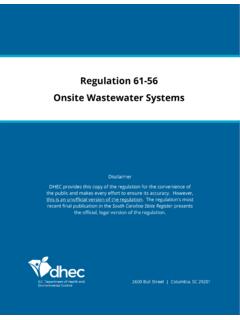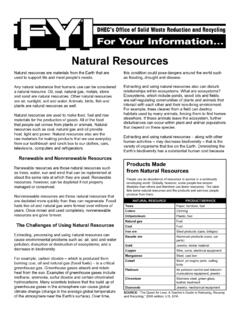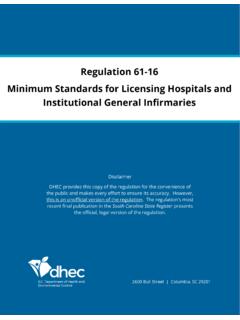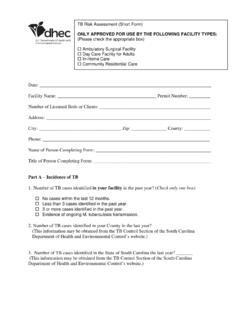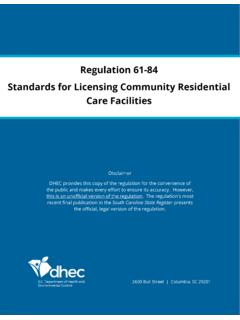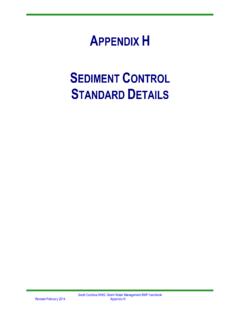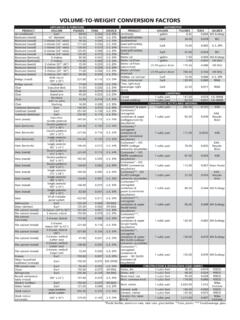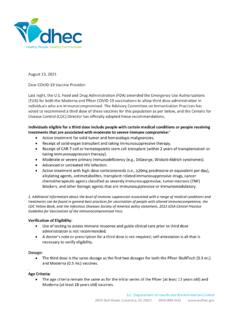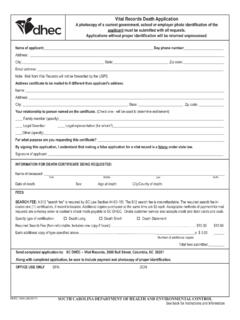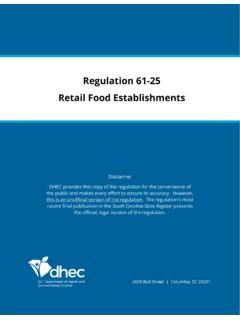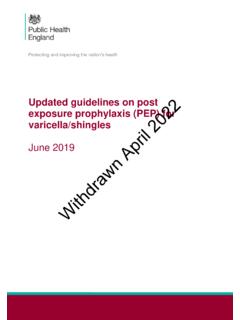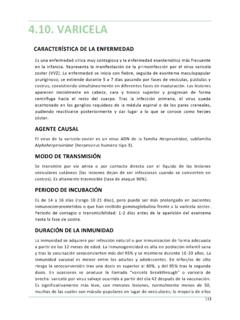Transcription of School and Childcare Exclusion List
1 School and Childcare Exclusion List Official School and Child Care Exclusion List of Contagious or Communicable Diseases Statutory authority: SC Code of Laws Sections 44-1-140, 44-29-200; 63-13-180. SC Code of Regulations Chapter 61-20 and Chapter 114, Article 5. Requirements South Carolina law requires schools to take measures to prevent the spread of disease in the School and Childcare populations by limiting the attendance of students and staff with contagious or infectious diseases at School and School activities. SC Regulation #61-20 requires DHEC to publish each year an Official School and Childcare Exclusion List of Contagious and Communicable Diseases, hereinafter referred to as the School and Childcare Exclusion List.
2 SC Law indicates that schools on account of the prevalence of any contagious or infectious diseases or to prevent the spread of disease, may prohibit or limit the attendance of any employee or student at any School or School -related activities under its control. SC Regulation states that schools, out-of-home Childcare providers, and parents/guardians should not allow the attendance of children with any contagious or infectious disease or syndrome requiring isolation if the disease or syndrome of the child or minor is on the Official School and Childcare Exclusion List of Contagious and Communicable Diseases.. Students, employees, and staff (including volunteers) are also excluded from School or Childcare attendance if they have been exposed to one or more of the conditions designated in these lists, until the return to School or Childcare criteria are met.
3 2021 Updates The following updates were made to the School and Childcare Exclusion Lists: Clarification of reporting requirements for individual cases and outbreaks to Public Health have been updated for the following conditions: Chicken Pox ( varicella ) and Diarrhea (Campylobacter, Cryptosporidium, E. coli 0157:H7 and other Shiga Toxin- Producing E. coli (STEC), Enteropathogenic E. coli (EPEC), Enterotoxigenic E. coli (ETEC), Giardia, Salmonella Typhi (Typhoid fever), Nontyphoidal Salmonella, and Shigella). Updates to the School and Childcare Exclusion List were effective June 2021. August 2021 Revisions: Exclusion criteria for close contacts (exposures) revised 1. Revisions 8/24/2021: Close contact definition provided in footnote Revisions 10/12/2021: Close contact definition revised Revisions 12/31/2021: Isolation and quarantine criteria for return revised Revisions 01/08/2022: Isolation and quarantine criteria for return revised Revisions 01/15/2022: Allowance for teachers and School staff to continue to work during quarantine in times of crisis staffing conditions.
4 Criteria for return from quarantine of negative test on day 4 or later amended to be strongly recommended for students. Test-to-stay program testing criteria changed to require one negative test between days 5-7. Revisions 02/13/2022: Test-to-stay program recommendations updated for Childcare centers. Revisions 02/16/2022. Report outbreaks of COVID-19 IMMEDIATELY by phone to Public Health. Revisions 02/22/2022. Exclusion criteria for close contacts (exposures) revised 2. Guidance for Implementing the School and Childcare Exclusion List 1. The School and Childcare Exclusion List applies to the following groups of people in out-of- home Childcare , (as defined in Code Ann. Section 63-13-20), and in any public, private, parochial, church or Sunday School (Reg 61-20).
5 O Children and staff in out-of-home Childcare settings;. o Preschool/kindergarten students in grades 3K, 4K, and 5K;. o Students in grades 1-12; and o School employees and staff (including volunteers) who have contact with students. 2. Parent Notification: Schools and Childcare providers are encouraged to distribute the list of conditions that require Exclusion from School attendance to parents/guardians, and/or distribute parent brochures developed by DHEC. The list is also available at 3. Parent Reporting to School : Schools and Childcare providers should inform parents/guardians that they must notify the School within 24 hours after the child has developed a known or suspected communicable illness addressed on the Exclusion List.
6 4. Return to School : Students, children and staff may return to the School as soon as their symptoms are resolved, unless stated otherwise in the Exclusion List or by their health care provider. 5. Special Circumstances: Immunocompromised or medically fragile children with an excludable condition or exposure may need longer periods of Exclusion , subject to recommendations by their health care provider(s) or by DHEC. For the purposes of School Exclusion , the term medically fragile refers to those students with special health care needs or developmental delays who require close assistance with feeding or other personal hygiene activities by which communicable illnesses may be easily spread. Nothing in these criteria precludes the exercise of the professional judgment of the local education agency medical and/or nursing staff to protect the health of students.
7 6. Exclusion criteria that vary by age or grade level are indicated in the Exclusion List. Young children or younger children as indicated in the List are generally those in Childcare , preschool, or kindergarten grades. When students are taught or routinely spend time in mixed age groups, the standards for the youngest children in the group apply. Conditions that do not require Exclusion for School and/or Childcare staff are indicated in the tables on the following pages. 7. Notes / Documentation for Return: A student may return to School as indicated in the tables that follow. Physicians, advanced practice registered nurses (APRNs), or physician assistants may provide medical notes for return to School following an excludable condition or DHEC may provide a release to return based on a negative test result or other circumstance.
8 Medical notes, which document diagnosis, initiation of treatment, improvement in status, etc., and parent notes should be kept on file at the School for at least one calendar year, or as otherwise required by local School district policy. Medical notes may not shorten or abrogate the minimum period of Exclusion required by DHEC for any specific condition. 8. Period of Exclusion : If a student does not respond to treatment for an excludable condition, the health care provider or health department may suggest longer periods of Exclusion . 3. Guidance for Implementing the School and Childcare Exclusion List 9. Outbreaks: During disease outbreaks or under special circumstances, DHEC may change the length of the Exclusion periods.
9 During outbreaks, Exclusion criteria may also apply to students, children and staff who are not confirmed by laboratory testing but who display the same symptoms of illness as lab- confirmed cases. 10. Minor illnesses: Conditions that are transmissible and may affect a child's ability to participate in normal activities, but that generally do not result in severe illness. Selected examples include conjunctivitis, fifth disease, hand-foot-mouth disease, scabies, head lice, and Strep throat. Consider consultation with a medical consultant for other conditions if there are questions about opening an investigation or initiating an outbreak response. Outbreaks of diarrheal illnesses ( , known or suspected Norovirus outbreaks) are investigated per applicable policies.
10 11. Disease/Outbreak reporting to the Health Department and the Family Education Rights and Privacy Act (FERPA): DHEC has determined that conditions reportable immediately or within 24. hours by phone, including all clusters or outbreaks of illnesses, fall under the FERPA allowance and exception of reporting illnesses without parental consent. Conditions that are reportable within 3. days may be reported to DHEC by name with parental consent or reported de-identified without parental consent. 12. The requirement to report Immediately Reportable or Urgently Reportable (within 24 hours). conditions applies to physicians, laboratories, health facilities, and any person or entity that maintains a database containing health care data.
